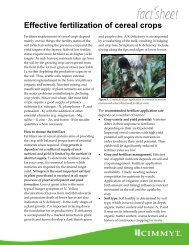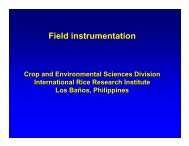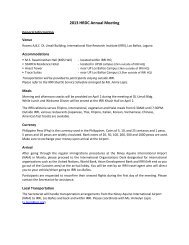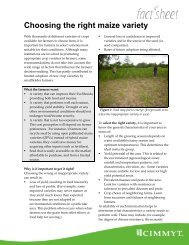Water management in irrigated rice - Rice Knowledge Bank ...
Water management in irrigated rice - Rice Knowledge Bank ...
Water management in irrigated rice - Rice Knowledge Bank ...
- No tags were found...
Create successful ePaper yourself
Turn your PDF publications into a flip-book with our unique Google optimized e-Paper software.
Table 3.7. Average performance of aerobic <strong>rice</strong>, lowland <strong>rice</strong>, and maize near Kaifeng, northernCh<strong>in</strong>a, 2002-03. Unpublished data from Ch<strong>in</strong>a Agricultural University and IRRI.Item Lowland <strong>rice</strong> Aerobic <strong>rice</strong> MaizeNumber of farmers, 2002 5 7 3Field size (ha) 0.12 0.12 0.15Yield (t ha −1 ) 7.3 4.4 7.5Irrigation (mm) 1,407 217 77Ra<strong>in</strong>fall (mm) 337 337 337Total water (mm) 1,744 553 414WP IR(g gra<strong>in</strong> kg −1 total water) 0.42 0.79 1.81Input costs ($ ha −1 ) 379 230 140Production value ($ ha −1 ) 1,097 706 1,071Net <strong>in</strong>come ($ ha −1 ) 718 487 906Own labor (d ha −1 ) 116 93 109Net <strong>in</strong>come (<strong>in</strong>clud<strong>in</strong>g labor) ($ ha −1 ) 500 312 703Number of farmers, 2003 2 6 3Field size (ha) 0.11 0.11 0.56Yield (t ha –1 ) 3,7 3.0 5.7Irrigation (mm) 476 156 0Ra<strong>in</strong>fall (mm) 674 674 674Total water (mm) 1,149 830 674WP IR(g gra<strong>in</strong> kg −1 total water) 0.32 0.36 0.85Input costs ($ ha −1 ) 378 261 129Production value ($ ha −1 ) 643 520 856Net <strong>in</strong>come ($ ha −1 ) 265 259 727Own labor (d ha −1 ) 162 75 41Net <strong>in</strong>come (<strong>in</strong>clud<strong>in</strong>g labor) ($ ha −1 ) −34 120 651<strong>rice</strong> varieties <strong>in</strong> farmers’ fields <strong>in</strong> ra<strong>in</strong>fed uplands<strong>in</strong> the Philipp<strong>in</strong>es. Though the amount of ra<strong>in</strong>fallwas not reported, the conditions of the trials weredescribed as “well watered.” Bouman et al (2005)and Peng et al (2006) quantified yield and wateruse of the recently released tropical aerobic <strong>rice</strong>variety Apo under <strong>irrigated</strong> aerobic and floodedconditions. In the dry season, yields under aerobicconditions were 4−5.7 t ha −1 and <strong>in</strong> the wet seasonthey were 3.5−4.2 t ha −1 . These yields were obta<strong>in</strong>ed<strong>in</strong> relatively wet soil with seasonal-average soilmoisture tensions <strong>in</strong> the root zone of 10−12 kPaand with maximum values of around 40 kPa. Onaverage, the mean yield of all varieties was 32%lower under aerobic conditions than under floodedconditions <strong>in</strong> the dry season and 22% lower <strong>in</strong> thewet season. Total water <strong>in</strong>put was 1,240−1,880mm <strong>in</strong> flooded fields and 790−1,430 mm <strong>in</strong> aerobicfields. On average, aerobic fields used 190 mm lesswater <strong>in</strong> land preparation and had 250−300 mm lessseepage and percolation, 80 mm less evaporation,and 25 mm less transpiration than flooded fields.Successful examples of the adoption of aerobic<strong>rice</strong> by farmers <strong>in</strong> the tropics are <strong>in</strong> some ra<strong>in</strong>feduplands <strong>in</strong> Batangas Prov<strong>in</strong>ce, Philipp<strong>in</strong>es (Atl<strong>in</strong> etal 2006). In the hilly regions of Yunnan Prov<strong>in</strong>ce,southern Ch<strong>in</strong>a, farmers grow ra<strong>in</strong>fed aerobic <strong>rice</strong>under <strong>in</strong>tensified <strong>management</strong>, realiz<strong>in</strong>g yields of3−4 t ha −1 (Atl<strong>in</strong> et al 2006).26





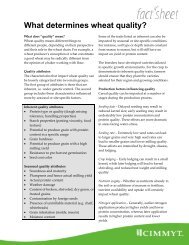

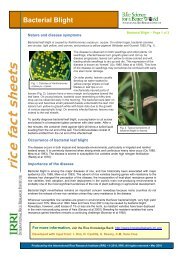

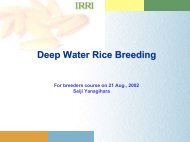
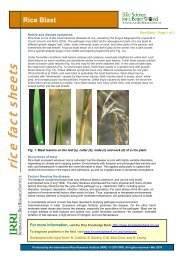
![International Standards' Organization â Rice Specification [ISO 7301]](https://img.yumpu.com/36696862/1/190x245/international-standards-organization-a-rice-specification-iso-7301.jpg?quality=85)

